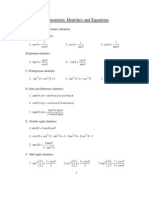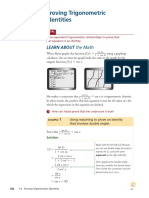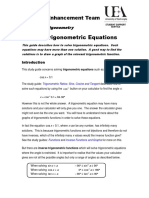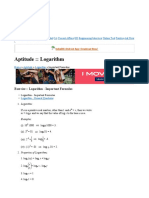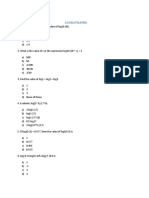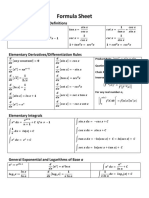Solving Linear Trig Equations
Uploaded by
tsubasa.iyamaSolving Linear Trig Equations
Uploaded by
tsubasa.iyamaIn Summary
Key Idea
• The same strategies can be used to solve linear trigonometric equations when
the variable is measured in degrees or radians.
Need to Know
• Because of their periodic nature, trigonometric equations have an infinite
number of solutions. When we use a trigonometric model, we usually want
solutions within a specified interval.
• To solve a linear trigonometric equation, use special triangles, a calculator, a
sketch of the graph, and/or the CAST rule.
• A scientific or graphing calculator provides very accurate estimates of the value
for an inverse trigonometric function. The inverse trigonometric function of a
positive ratio yields the related angle. Use the related acute angle and the
period of the corresponding function to determine all the solutions in the given
interval.
• You can use a graphing calculator to verify the solutions for a linear
trigonometric equation by
• graphing the appropriate functions on the graphing calculator and
determining the points of intersection
• graphing an equivalent single function and determining its zeros
CHECK Your Understanding
y 1. Use the graph of y 5 sin u to estimate the value(s) of u in the interval
1 0 # u # 2p.
y = sin u a) sin u 5 1 c) sin u 5 0.5 e) sin u 5 0
u !3
b) sin u 5 21 d) sin u 5 20.5 f ) sin u 5
0 p p 3p 2p 2
2 2
2. Use the graph of y 5 cos u to estimate the value(s) of u in the interval
–1 0 # u # 2p.
a) cos u 5 1 c) cos u 5 0.5 e) cos u 5 0
y !3
b) cos u 5 21 d) cos u 5 20.5 f ) cos u 5
1 2
y = cos u !3
3. Solve sin x 5 , where 0 # x # 2p.
u 2
a) How many solutions are possible?
0 p p 3p 2p
2 2 b) In which quadrants would you find the solutions?
c) Determine the related acute angle for the equation.
–1
d) Determine all the solutions for the equation.
426 7.5 Solving Linear Trigonometric Equations NEL
7.5
4. Solve cos x 5 20.8667, where 0° # x # 360°.
a) How many solutions are possible?
b) In which quadrants would you find the solutions?
c) Determine the related angle for the equation, to the nearest degree.
d) Determine all the solutions for the equation, to the nearest degree.
5. Solve tan u 5 2.7553, where 0 # u # 2p.
a) How many solutions are possible?
b) In which quadrants would you find the solutions?
c) Determine the related angle for the equation, to the nearest
hundredth.
d) Determine all the solutions for the equation, to the nearest
hundredth.
PRACTISING
6. Determine the solutions for each equation, where 0 # u # 2p.
!3
K
1
!2
a) tan u 5 1 c) cos u 5 e) cos u 5 2
2
!3
f ) tan u 5 !3
1
!2
b) sin u 5 d) sin u 5 2
2
7. Using a calculator, determine the solutions for each equation on the
interval 0° # u # 360°. Express your answers to one decimal place.
a) 2 sin u 5 21 d) 23 sin u 2 1 5 1
b) 3 cos u 5 22 e) 25 cos u 1 3 5 2
c) 2 tan u 5 3 f ) 8 2 tan u 5 10
8. Using a calculator, determine the solutions for each equation, to two
decimal places, on the interval 0 # x # 2p.
a) 3 sin x 5 sin x 1 1 c) cos x 2 1 5 2cos x
b) 5 cos x 2 !3 5 3 cos x d) 5 sin x 1 1 5 3 sin x
9. Using a calculator, determine the solutions for each equation, to two
decimal places, on the interval 0 # x # 2p.
a) 2 2 2 cot x 5 0 d) 2 csc x 1 17 5 15 1 csc x
b) csc x 2 2 5 0 e) 2 sec x 1 1 5 6
c) 7 sec x 5 7 f ) 8 1 4 cot x 5 10
10. Using a calculator, determine the solutions for each equation, to two
decimal places, on the interval 0 # x # 2p.
1 !3 1
!2
a) sin 2x 5 c) sin 3x 5 2 e) cos 2x 5 2
2 2
1 1 x !3
!2
b) sin 4x 5 d) cos 4x 5 2 f ) cos 5
2 2 2
NEL Chapter 7 427
11. A city’s daily high temperature, in degrees Celsius, can be modelled by
A 2p
the function t(d ) 5 228 cos 365d 1 10, where d is the day of the
year and 1 5 January 1. On days when the temperature is
approximately 32 °C or above, the air conditioners at city hall are
turned on. During what days of the year are the air conditioners
running at city hall?
12. The height, in metres, of a nail in a water wheel above the surface of
the water, as a function of time, can be modelled by the function
p
h(t) 5 24 sin 4 (t 2 1) 1 2.5, where t is the time in seconds.
During what periods of time is the nail below the water in the first
24 s that the wheel is rotating?
13. Solve sin Qx 1 R 5 !2 cos x for 0 # x # 2p.
p
4
T
14. Sketch the graph of y 5 sin 2u for 0 # u # 2p. On the graph,
C
clearly indicate all the solutions for the trigonometric equation
1
sin 2u 5 2 !2.
p
15. Explain why the value of the function f (x) 5 25 sin
50
(x 1 20) 2 55
at x 5 3 is the same as the value of the function at x 5 7.
16. Create a table like the one below to compare the algebraic and
graphical strategies for solving a trigonometric equation. In what ways
are the strategies similar, and in what ways are they different? Use
examples in your comparison.
Method for Solving
Algebraic Strategy Graphical Strategy
Similarities
Differences
Extending
17. Solve the trigonometric equation 2 sin x cos x 1 sin x 5 0. (Hint: You
may find it helpful to factor the left side of the equation.)
18. Solve each equation for 0 # x # 2p.
a) sin 2x 2 2 cos2 x 5 0 b) 3 sin x 1 cos 2x 5 2
428 7.5 Solving Linear Trigonometric Equations NEL
sin x 1 sin 2x p 5p p 2p p 5p
13. 5 tan x c) or f) or 13. x 5 or
1 1 cos x 1 cos 2x 6 6 3 3 4 4
sin x 1 2 sin x cos x 2p 4p 14. y
5 tan x 2. a) 0 or 2p d) or 1.5
1 1 cos x 1 cos 2x 3 3
sin x(1 1 2 cos x) p 3p 1.0
1 1 cos x 1 cos 2x
5 tan x b) p e) or
2 2 0.5 _ 13p
8
,– 2+
2
p 5p p 11p x
sin x(1 1 2 cos x) c) or f ) or
5 tan x 3 3 6 6 0 p p 3p
cos x 1 (1 1 cos 2x)
p –0.5 2 2
sin x(1 1 2 cos x) 3. a) 2 c) x 5
5 tan x 3 –1.0
cos x 1 2 cos2 x
p 2p _ 5p ,– 2+
sin x(1 1 2 cos x)
5 tan x
b) quadrants I and II d) x 5 and –1.5
8 2 _ 7p
8
, – 2 + _ 15p , – 2 +
2 8 2
3 3
cos x(1 1 2 cos x)
4. a) 2 15. The value of f (x) 5 sin x is the same at x
sin x
5 tan x b) quadrants II and III and p 2 x. In other words, it is the same
cos x
c) 30° at x and half the period minus x. Since the
tan x 5 tan x p
d) x 5 150° or 210° period of f (x) 5 25 sin 50 (x 1 20) 2 55
14.
5. a) 2
is 100, if the function were not
Definition Methods of Proof b) quadrants I and III horizontally translated, its value at x would
c) 1.22 be the same as at 50 2 x. The function is
A statement of the Both sides of the
d) u 5 1.22 or 4.36 horizontally translated 20 units to the left,
equivalence of two equation must be
p 5p however, so it goes through half its period
trigonometric shown to be 6. a) u 5 or
4 4 from x 5 220 to x 5 30. At x 5 3, the
expressions equivalent through
p 3p function is 23 units away from the left end
graphing or b) u 5 or
simplifying/rewriting. 4 4 of the range, so it will have the same value
p 11p at x 5 30 2 23 or x 5 7, which is
c) u 5 or 23 units away from the right end of the
6 6
4p 5p range.
Trigonometric Identities d) u 5 or 16. To solve a trigonometric equation
3 3
algebraically, first isolate the
3p 5p
e) u 5 or trigonometric function on one side of the
4 4 equation. For example, the trigonometric
Examples Non-Examples p 4p equation 5 cos x 2 3 5 2 would become
f ) u 5 or
cos 2x 1 sin2 x cos 2x 2 2 sin2 x 5 1 3 3 5 cos x 5 5, which would then become
5 cos2 x cot2 x 1 csc2 x 5 1 7. a) u 5 210° or 330° cos x 5 1. Next, apply the inverse of the
cos 2x 1 1 5 2 cos2 x b) u 5 131.8° or 228.2° trigonometric function to both sides of
c) u 5 56.3° or 236.3° the equation. For example, the trigonometric
15. She can determine whether the equation d) u 5 221.8° or 318.2° equation cos x 5 1 would become
2 sin x cos x 5 cos 2x is an identity e) u 5 78.5° or 281.5° x 5 cos21 1. Finally, simplify the
by trying to simplify and/or rewrite f ) u 5 116.6° or 296.6° equation. For example, x 5 cos21 1 would
the left side of the equation so that it is 8. a) x 5 0.52 or 2.62 become x 5 0 1 2np, where nPI.
equivalent to the right side of the equation. b) x 5 0.52 or 5.76 To solve a trigonometric equation
Answers
Alternatively, she can graph the functions c) x 5 1.05 or 5.24 graphically, first isolate the trigonometric
y 5 2 sin x cos x and y 5 cos 2x and see if d) x 5 3.67 or 5.76 function on one side of the equation. For
the graphs are the same. If they’re the 9. a) x 5 0.79 or 3.93 example, the trigonometric equation
same, it’s an identity, but if they’re not the b) x 5 0.52 or 2.62 5 cos x 2 3 5 2 would become
same, it’s not an identity. By doing this she c) x 5 0 or 6.28 5 cos x 5 5, which would then become
can determine it’s not an identity, but she d) x 5 3.67 or 5.76 cos x 5 1. Next, graph both sides of the
can make it an identity by changing the e) x 5 1.16 or 5.12 equation. For example, the functions
equation to 2 sin x cos x 5 sin 2x. f ) x 5 1.11 or 4.25 f (x) 5 cos x and f (x) 5 1 would both
16. a) a 5 2, b 5 1, c 5 1 10. a) x 5 0.39, 1.18, 3.53, or 4.32 be graphed. Finally, find the points where
b) a 5 21, b 5 2, c 5 22 b) x 5 0.13, 0.65, 1.70, 2.23, 3.27, 3.80, the two graphs intersect. For example,
17. cos 4x 1 4 cos 2x 1 3; a 5 1, 4.84, or 5.37 f (x) 5 cos x and f (x) 5 1 would
b 5 4, c 5 3 c) x 5 1.40, 1.75, 3.49, 3.84, 5.59, or intersect at x 5 0 1 2np, where nPI.
5.93 Similarity: Both trigonometric functions
d) x 5 0.59, 0.985, 2.16, 2.55, 3.73, are first isolated on one side of the
Lesson 7.5, pp. 426–428 4.12, 5.304, or 5.697 equation.
p 7p 11p e) x 5 1.05, 2.09, 4.19, or 5.24 Differences: The inverse of a trigonometric
1. a) d) or f ) x 5 1.05 function is not applied in the graphical
2 6 6
3p 11. from about day 144 to about day 221 method, and the points of intersection are
b) e) 0, p, or 2p 12. 1.86 s , t , 4.14 s; not obtained in the algebraic method.
2
9.86 s , t , 12.14 s;
17.86 s , t , 20.14 s
NEL Answers 665
2p p 5p solution in the interval 0 # x # 2p (p),
17. x 5 0 1 np, 1 2np, and 8. a) x 5 or
3 3 3 because cos x 5 21 for only one value of x.
4p p 5p 7p 11p p 5p
1 np, where nPI b) x 5 , , , or 17. a5 ,
3 6 6 6 6 4 4
p p 5p 3p p 3p
18. a) x 5 , , , or c) x 5 0, 0.96 p, 5.33, or 2p 18. x 5 0.72, , p, , or 5.56
4 2 4 4 2 2
p p 5p 3p 7p 19. x 5 15°, 75°, 105°, 165°, 195°, 255°,
b) x 5 , , or d) x 5 or
6 2 6 4 4 285°, or 345°
p p 3p 5p 3p 7p 20. u 5 0.96
Lesson 7.6, pp. 435–437 e) x 5 , , , , , or
4 2 4 4 2 4
1. a) (sin u) (sin u 2 1) p 5p 7p 11p Chapter Review, p. 440
f ) x 5 0, , , p, , , or 2p
b) (cos u 2 1) (cos u 2 1) 6 6 6 6 7p
1. a) Answers may vary. For example, sin 10 .
c) (3 sin u 1 2) (sin u 2 1) p 5p
9. a) x 5 , 1.98, 4.30, or 8p
b) Answers may vary. For example, cos 7 .
d) (2 cos u 2 1) (2 cos u 1 1) 3 3
e) (6 sin x 2 2) (4 sin x 1 1) 2p 4p 6p
b) x 5 0.45, , , or 5.83 c) Answers may vary. For example, sin 7 .
f) (7 tan x 1 8) (7 tan x 2 8) 3 3
!3
p
p 5p 7p 11p p 5p d) Answers may vary. For example, cos 7 .
2. a) y56 ,x5 , , , or c) x 5 , 0.85, , or 2.29
3 6 6 6 6 6 6 2. y 5 5 cos (x) 2 8
b) y 5 0 or 21, x 5 0, p,
3p
, or 2p p 7p 11p !3 1
2 d) x 5 , , or 3. a) cos x 2 sin x
2 6 6 2 2
!2 !2
1 p p 5p 3p 10. x 5 0.15, 1.02, 2.12, or 2.99
c) y 5 0 or z 5 , x 5 , , , or
2 6 2 6 2 11. b 5 1 1 !3, c 5 !3 b) 2
2
cos x 2
2
sin x
tan x 1 !3
d) y 5 0 or z 5 1, x 5 0, p, or 2p 1
12. c5
1 2 !3 tan x
1 1 2 c)
3. a) y 5 or
3 2
!2 !2
p 2p
b) x 5 1.05, 1.91, 4.37, or 5.24 13. km , d , km,
3 3 d) 2 cos x 2 sin x
4. a) u 5 90° or 270° 2 2
b) u 5 0°, 180°, or 360° 4p
km , d ,
5p
km !3 !3
3 3 4. a) 2 b) 2
c) u 5 45°, 135°, 225°, or 315° 3 2
d) u 5 60°, 120°, 240°, or 300° 14. x 5 1.91 or 4.37 1 !2
3p 5p 5. a) c) 2
e) u 5 30°, 150°, 210°, or 330° 15. a) x 5 or 2 2
u 5 45°, 135°, 225°, or 315° 4 4 !3
d) !3
f)
5. a) x 5 0°, 90°, 180°, 270°, or 360° 3p 5p b)
b) x 5 1 2np or 1 2np, where 2
b) x 5 0°, 180°, or 360° 4 4
24 7
c) x 5 90° or 270° nPI 6. a) sin 2x 5 , cos 2x 5 ,
d) x 5 60°, 90°, 120°, or 270° 16. It is possible to have different numbers of 25 25
solutions for quadratic trigonometric 24
e) x 5 45°, 135°, 225°, or 315° tan 2x 5
f) x 5 90° or 180° equations because, when factored, a 7
p p 5p 3p quadratic trigonometric equation 336 527
6. a) x5 , , , or b) sin 2x 5 2 , cos 2x 5 2 ,
6 2 6 2 can be one expression multiplied by 625 625
3p another expression or it can be a single 336
b) x5 tan 2x 5
2 expression squared. For example, the 527
3 1 120 119
5p 7p equation cos2 x 1 2 cos x 1 2 becomes c) sin 2x 5 2 , cos 2x 5 ,
c) x 5 0, , p, , or 2p 169 169
(cos x 1 1) Qcos x 1 2 R when
6 6 1 120
p 4p 5p tan 2x 5 2
d) x5 , , or 2p 119
3 3 3 factored, and it has the solutions 3 , p,
7. a) trigonometric identity
p 3p 5p 7p 4p
e) x5 , , , or and 3 in the interval 0 # x # 2p. b) trigonometric equation
4 4 4 4 c) trigonometric identity
3p In comparison, the equation
f) x 5 0, , or 2p cos2 x 1 2 cos x 1 1 5 0 becomes
d) trigonometric equation
2 cos2 x
p 5p (cos x 1 1) 2 when factored, and it has 8. 5 1 2 cos2 x
7. a) u 5 , p, or only one solution, p, in the interval cot2 x
3 3
0 # x # 2p. Also, different expressions cos2 x
p 5p 3p 5 1 2 cos2 x
b) u5 , , or produce different numbers of solutions. For cos2 x
6 6 2 1
c) u5p example, the expression cos x 1 2 produces sin2 x
p 5p two solutions in the interval 0 # x # 2p (cos2 x) (sin2 x)
d) u 5 or 5 1 2 cos2 x
cos2 x
6 6 Q 3 and 3 R because cos x 5 2 2 for two
2p 4p 1
p 5p sin2 x 5 1 2 cos2 x
e) u 5 , 2.82, , or 5.96 different values of x. The expression 1 2 cos2 x 5 1 2 cos2 x
4 4
f) u 5 0.73, 2.41, 3.99, or 5.44 cos x 1 1, however, produces only one
666 Answers NEL
You might also like
- Module in Pre Calculus Grade 11 Second Quarter, Week 6 To Week 8No ratings yetModule in Pre Calculus Grade 11 Second Quarter, Week 6 To Week 826 pages
- Inverse Tigonometric Functions PPT BenitezNo ratings yetInverse Tigonometric Functions PPT Benitez42 pages
- 5-2 Verifying Trigonometric Identities PDF100% (2)5-2 Verifying Trigonometric Identities PDF25 pages
- Trigonometry Parts 3 and 4 - Trigonometric Graphs and EquationsNo ratings yetTrigonometry Parts 3 and 4 - Trigonometric Graphs and Equations26 pages
- Lesson 7: Trigonometric Equations by Thomas E. PriceNo ratings yetLesson 7: Trigonometric Equations by Thomas E. Price19 pages
- 7.05 - Solving - Trigonometric - EquationsNo ratings yet7.05 - Solving - Trigonometric - Equations13 pages
- XI Mathematics IIT JEE Advanced Study Package 2014 15100% (1)XI Mathematics IIT JEE Advanced Study Package 2014 15527 pages
- XI Mathematics IIT JEE Advanced Study Package 2014 159No ratings yetXI Mathematics IIT JEE Advanced Study Package 2014 159527 pages
- Steps Into Trigonometry Solving Trigonometric EquationsNo ratings yetSteps Into Trigonometry Solving Trigonometric Equations6 pages
- General Solution of Trigonometric EquationsNo ratings yetGeneral Solution of Trigonometric Equations22 pages
- Pre Calculus Q2 Week 7 Trigonometric IdentitiesNo ratings yetPre Calculus Q2 Week 7 Trigonometric Identities48 pages
- Trigonometric Equations: A B B A A B A B C A BNo ratings yetTrigonometric Equations: A B B A A B A B C A B2 pages
- 8 Trigonometric Functions and IdentitiesNo ratings yet8 Trigonometric Functions and Identities86 pages
- Sosina School Math Grade - 11&12 by EndalewNo ratings yetSosina School Math Grade - 11&12 by Endalew5 pages
- GCSE Trigonometry Revision Cards: SohcahtoaNo ratings yetGCSE Trigonometry Revision Cards: Sohcahtoa5 pages
- Review For Unit 3 - Chapter 3 Part 2: Sin Xisthesameas (Sinx) Know The Unit Circle!!No ratings yetReview For Unit 3 - Chapter 3 Part 2: Sin Xisthesameas (Sinx) Know The Unit Circle!!16 pages
- 15 - 1 Defining and Evaluating A Logarithmic FunctionNo ratings yet15 - 1 Defining and Evaluating A Logarithmic Function16 pages
- © Ncert Not To Be Republished: Trigonometric FunctionsNo ratings yet© Ncert Not To Be Republished: Trigonometric Functions27 pages
- Chapter 16 Alternating Voltages and CurrentsNo ratings yetChapter 16 Alternating Voltages and Currents24 pages
- Trigonometric Functions (2) - Vijay AssignmentNo ratings yetTrigonometric Functions (2) - Vijay Assignment3 pages
- Formula Sheet: Trigonometric Identities/DefinitionsNo ratings yetFormula Sheet: Trigonometric Identities/Definitions2 pages





